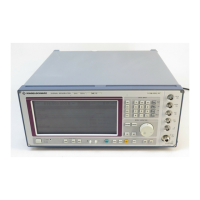SME Digital Modulation
1038.6002.02 2.81 E-13
2.6.3.3 DM Memory Extension, Option SME-B12
Option SME-B12, memory extension, increases the memory depth of the data generator. The memory
depth depends on the selection of the memory space allocation (MEM MODE, cf. submenu CONFIG
XMEM...). If the entire memory area is allocated to the DATA memory (MEM MODE 8M*1), the memory
depth is increased to 8 MBit. If the memory area is divided up into the three memories DATA, LEV-ATT
and BURST (MEM MODE 1M*3), however, the memory depth is decreased to 1 MBit.
In the DM menus, the memory extension can be activated in submenu SELECT LIST... by selecting list
"XMEM".
FREQUENCY
LEVEL
MODULATION
DIGITAL MOD
LF OUTPUT
SWEEP
LIST
MEM SEQ
UTILITIES
HELP
GMSK
GFSK
QPSK
FSK
4FSK
FFSK
FREQ
100. 000 000 0
MHz
LEVEL dBm
CREATE NEW LIST
DLIST1 15
DLIST2 325
DLIST3 500
XMEM 8388607
- 30. 0
SOURCE
PRBS
CLOCK...
LEVEL ATTENUATION MODE
LEVEL ATTENUATION
MODE
SELECT STANDARD...
FILTER / BIT RATE...
DIFF ENCODER
MOD POLARITY
SELECT LIST...
DELETE LIST...
CONFIG XMEM...
Fig. 2-39 Selection of the memory extension in submenu SELECT LIST...
Compared to all other lists, list "XMEM" is special for the following reasons:
• It cannot be processed using the list editor. The data are either loaded externally via the DATA
socket (RECORD DATA
→
) or entered via the IEC bus or the RS-232 interface.
• List "XMEM" cannot be deleted. The previous data of a certain memory area are overwritten when
new data are read into this memory area.
• List "XMEM" can be divided up into several sublists (memory areas). The memory areas are defined
by the start address and the length of the data sequence. Their contents is permanently stored.
For modulation types QPSK and 4FSK it should be noted that a symbol is coded with two bits, the X bit
and the Y bit. If data lists for these modulations are to be stored in the memory extension, three
operating modes can be selected, each storing the X and Y bits in the "XMEM" list in a different way.
Switchover between the different modes is not possible without a change of the XMEM data:

